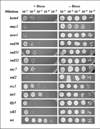Identification of genes required for protection from doxorubicin by a genome-wide screen in Saccharomyces cerevisiae
- PMID: 18056469
- PMCID: PMC3635107
- DOI: 10.1158/0008-5472.CAN-07-2399
Identification of genes required for protection from doxorubicin by a genome-wide screen in Saccharomyces cerevisiae
Abstract
Anthracyclines are chemotherapeutic agents commonly used to treat a broad range of malignancies. Although effective, these drugs present serious complications, most notably cardiotoxicity. To determine the mechanisms that mediate cytoprotection from doxorubicin, we have screened the collection of Saccharomyces cerevisiae haploid gene deletion mutants. We have identified 71 deletion strains that display varying degrees of hypersensitivity to doxorubicin at a concentration that does not significantly reduce the viability of wild-type cells. Complementation of the doxorubicin-sensitive phenotype of the deletion strains with the wild-type genes proves that the sensitivity of the strain to doxorubicin is due to the gene deletion. The genes that mediate cytoprotection from doxorubicin belong to multiple pathways including DNA repair, RNA metabolism, chromatin remodeling, amino acid metabolism, and heat shock response. In addition, proteins with mitochondrial, osmosensing, vacuolar, and ribosomal functions are also required for protection from doxorubicin. We tested the sensitivity of the deletion strains to other cytotoxic agents, which resulted in different drug-specific sensitive groups. Most of the identified genes have mammalian homologues that participate in conserved pathways. Our data may prove useful to develop strategies aimed at sensitizing tumor cells to doxorubicin as well as protecting cardiac cells from its cytotoxic effects.
Figures



Similar articles
-
Genome-wide screen identifies genes whose inactivation confer resistance to cisplatin in Saccharomyces cerevisiae.Cancer Res. 2005 Jul 1;65(13):5890-7. doi: 10.1158/0008-5472.CAN-04-4093. Cancer Res. 2005. PMID: 15994967
-
Comparative genome-wide screening identifies a conserved doxorubicin repair network that is diploid specific in Saccharomyces cerevisiae.PLoS One. 2009 Jun 8;4(6):e5830. doi: 10.1371/journal.pone.0005830. PLoS One. 2009. PMID: 19503795 Free PMC article.
-
Small ubiquitin-related modifier pathway is a major determinant of doxorubicin cytotoxicity in Saccharomyces cerevisiae.Cancer Res. 2007 Jan 15;67(2):765-72. doi: 10.1158/0008-5472.CAN-06-2839. Cancer Res. 2007. PMID: 17234788
-
Chemical-genetic approaches for exploring the mode of action of natural products.Prog Drug Res. 2008;66:237, 239-71. doi: 10.1007/978-3-7643-8595-8_5. Prog Drug Res. 2008. PMID: 18416308 Review.
-
Doxorubicin, DNA torsion, and chromatin dynamics.Biochim Biophys Acta. 2014 Jan;1845(1):84-9. doi: 10.1016/j.bbcan.2013.12.002. Epub 2013 Dec 19. Biochim Biophys Acta. 2014. PMID: 24361676 Free PMC article. Review.
Cited by
-
yRACK1/Asc1 proxiOMICs-Towards Illuminating Ships Passing in the Night.Cells. 2019 Nov 4;8(11):1384. doi: 10.3390/cells8111384. Cells. 2019. PMID: 31689955 Free PMC article.
-
Structure-activity relationship (SAR) and preliminary mode of action studies of 3-substituted benzylthioquinolinium iodide as anti-opportunistic infection agents.Eur J Med Chem. 2013;70:130-42. doi: 10.1016/j.ejmech.2013.09.044. Epub 2013 Oct 5. Eur J Med Chem. 2013. PMID: 24141203 Free PMC article.
-
The Role of HSP40 Conserved Motifs in the Response to Cytotoxic Stress.J Nat Sci. 2018;4(4):e500. J Nat Sci. 2018. PMID: 29682607 Free PMC article.
-
A yeast phenomic model for the influence of Warburg metabolism on genetic buffering of doxorubicin.Cancer Metab. 2019 Oct 23;7:9. doi: 10.1186/s40170-019-0201-3. eCollection 2019. Cancer Metab. 2019. PMID: 31660150 Free PMC article.
-
Robustness and evolvability in natural chemical resistance: identification of novel systems properties, biochemical mechanisms and regulatory interactions.Mol Biosyst. 2010 Aug;6(8):1475-91. doi: 10.1039/c002567b. Epub 2010 Jun 2. Mol Biosyst. 2010. PMID: 20517567 Free PMC article.
References
-
- Arcamone F, Cassinelli G, Fantini G, et al. Adriamycin, 14-hydroxydaunomycin, a new antitumor antibiotic from S. peucetius var. caesius. Biotechnol Bioeng. 1969;11:1101–1110. - PubMed
-
- Weiss RB. The anthracyclines: will we ever find a better doxorubicin? Semin Oncol. 1992;19:670–686. - PubMed
-
- Kaklamani VG, Gradishar WJ. Epirubicin versus doxorubicin: which is the anthracycline of choice for the treatment of breast cancer? Clin Breast Cancer. 2003;4(Suppl 1):S26–S33. - PubMed
-
- Minotti G, Menna P, Salvatorelli E, Cairo G, Gianni L. Anthracyclines: molecular advances and pharmacologic developments in antitumor activity and cardiotoxicity. Pharmacol Rev. 2004;56:185–229. - PubMed
-
- Singal PK, Iliskovic N. Doxorubicin-induced cardio-myopathy. N Engl J Med. 1998;339:900–905. - PubMed
Publication types
MeSH terms
Substances
Grants and funding
LinkOut - more resources
Full Text Sources
Other Literature Sources
Molecular Biology Databases

